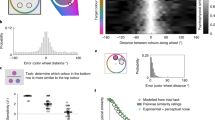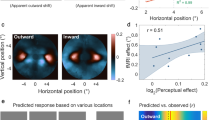Abstract
IF two objects of the same size are viewed so that one is twice as far from the eyes as the other, the retinal image of the farther object will be one-half the size of the image of the nearer object, but it does not appear half the size to the observer. They both appear almost the same size and the effect, which is due to perceptual interpretation of the retinal image, is known as size constancy1,2.
This is a preview of subscription content, access via your institution
Access options
Subscribe to this journal
Receive 51 print issues and online access
$199.00 per year
only $3.90 per issue
Buy this article
- Purchase on Springer Link
- Instant access to full article PDF
Prices may be subject to local taxes which are calculated during checkout
Similar content being viewed by others
References
Thouless, R. H., Brit. J. Psychol., 21, 339 (1931) ; 22, 1 (1931) ; 22, 216 (1932).
Vernon, M. D., A Further Study of Visual Perception (Cambridge Univ. Press, 1954).
Wohlgemuth, A., “On the After-Effect of Seen Movement,” Brit. J. Psychol. Monograph Supplement (Cambridge Univ. Press, 1911).
Duncker, K., “Induced Motion” in A Source Book of Gestalt Psychology, edit. by Ellis, W. (Routledge and Kegan Paul, London, 1938).
Author information
Authors and Affiliations
Rights and permissions
About this article
Cite this article
ANSTIS, S., SHOPLAND, C. & GREGORY, R. Measuring Visual Constancy for Stationary or Moving Objects. Nature 191, 416–417 (1961). https://doi.org/10.1038/191416a0
Issue Date:
DOI: https://doi.org/10.1038/191416a0
This article is cited by
Comments
By submitting a comment you agree to abide by our Terms and Community Guidelines. If you find something abusive or that does not comply with our terms or guidelines please flag it as inappropriate.



